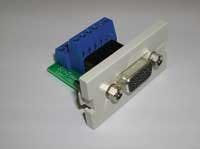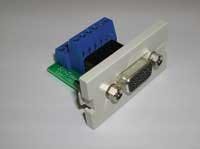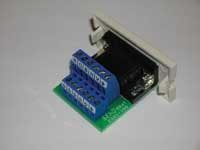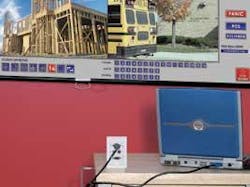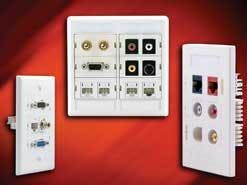Connectivity performance and connector housings can be a significant issue in K-12 multimedia projects.
Everyone is familiar with the real-estate industry mantra: location, location, location. The last few years have brought a similar refrain to the audio/video (A/V) and information-technology (IT) industries: convergence, convergence, convergence.
Almost every article you read in a trade publication like this one has a reference to how one system was “converged” with another to provide the customer an advantage in cost or ease of installation and management. The convergence that we read about usually deals with Internet Protocol (IP), which means routing your information via an Ethernet network that may or may not extend across the Internet.
Another distinct aspect of this convergence is more physical in nature. It has to do with the connectors and cabling that are used in structured cabling systems for both new and renovated communications infrastructures. As technology has invaded the education system, communications engineers and cabling vendors have adapted how they think about cabling and wiring classrooms to meet these new audio and video requirements.
Technology in the classroom
Most K-12 schools that are undergoing renovation or new construction have some money earmarked for technology. In the past, this typically meant Category 5e cabling to the rooms for data and telephones, and perhaps a coaxial cable for a television mounted in a corner. As audio and video systems have become more integrated into the learning process, it has caused a shift with respect to the associated cabling and connectivity.
Increasingly, audio and video signals are running over unshielded twisted-pair (UTP) cabling, whether it be Category 5e, Category 6, or even pre-standard Augmented Category 6. This “convergence” of sorts has meant that classrooms need connectors that serve data networks, telephone systems, and audio/video systems. This is of particular consequence when the classroom includes advanced A/V systems, such as ceiling-mounted projectors and sound-assist systems.
Almost every school district wants to implement digital video projectors in the classroom. Projectors and personal computers have become a significant part of teachers’ lesson plans, and I have heard numerous stories of teachers conveniently “forgetting” to return the projector cart one afternoon in order to have access to it the following morning.
Alongside the projector, many school systems install or want to install sound-assist systems, which typically consist of a wireless microphone, a mixer/wireless receiver/amplifier, and speakers in the ceiling or on the wall. The speakers enhance the teacher’s voice, on the theory that students learn better and pay closer attention when they hear the teacher’s voice coming from “everywhere” in the room. Some sound-assist systems allow alternate audio inputs to amplify not only the microphone signal, but also signals from up to three other sources.
This integration of audio and video signals with the IT infrastructure has mandated that many of the communications engineers who used to deal with UTP cabling exclusively now must design infrastructures that include the A/V systems and cabling.
Combining A/V and IT
When designing these systems, we must realize that most K-12 classrooms predominantly use a lecture-style teaching arrangement. Integrating projectors and technology means ceiling-mounting the projector and ceiling speakers, then routing all the cables to a faceplate at the teacher station or desk. In most schools, the teacher station serves as the technology cabinet and usually has a PC, VCR/DVD player, sound-assist amplifier, perhaps a printer and, in some cases, an Ethernet-based control unit.
From an infrastructure standpoint, the goal in A/V-IT convergence is to integrate all input and output signals to work as one communications system. An important consideration when you are designing a school’s or classroom’s cabling infrastructure is how to deal with all the telephone and data signals as well as the A/V signals, preferably using a single faceplate that houses connectors for all these systems. Some manufacturers are further along in their A/V product lines than others. The selection runs the gamut, from manufacturers that provide only F-connector pass-throughs to those that provide HD-15 video graphics array (VGA) connectors with screw connectors on the back.
A fact that may be either comforting or intimidating is that numerous options are available to integrate audio and video into classrooms. For example, a simple solution is to install a television in the corner of the room. On the other end of the spectrum, one can install in the teacher station a video/audio switcher that ties into a control unit and ceiling-mounted video projector. Of course, the amount of funds available for a project and the teachers’ tolerance of system complexity usually help the decision-making process.
Today, most schools settle on a system that includes a video projector that acts as the video switcher, and a sound-assist system that acts as the mixer for the audio from the PC and VCR/DVD player. Most also want a control system that lets the teacher use a PC to turn on the components and switch the projector between the different video inputs. This control system also connects to the IP network to let a centrally located IT professional view and remotely control the A/V systems in each classroom.
One of the biggest classroom technology issues for teachers is reliability and, more to the point, the time spent waiting for system troubleshooting. The IP control system lets the IT professional remotely connect to the classroom control system to diagnose and effect a fix that may be as simple as changing the video input on the projector.
Integrated product sets
As these systems invade the classroom, cable and connectivity manufacturers are being pushed to provide simple solutions that integrate all the connectors into a single faceplate. Some manufacturers have taken the next step of convergence and now provide audio and video modular connectors that fit into their standard faceplates in the form of the familiar Category 5e, or Category 6, 8-pin modular jack.
For years, connectivity-hardware manufacturers have offered 8-pin modular jacks and F-connector pass-throughs that fit into their faceplates. In a classroom, these faceplate types serve the Ethernet and telephone connections (8-pin modular) as well as cable TV (F-connector). Beyond these standard interfaces, what you get from a faceplate can be considered a reflection of the manufacturer’s dedication to the integration of A/V signals with IT infrastructure. Some provide a full complement of A/V connectors that also fit into their faceplates.
Our communications engineers recommend products that provide multiple audio and video connectors. These connectors come in several different styles, including pass-throughs for preterminated cables; solder connectors that attach directly to the connecting cable on the back and to the patch cable on the front; screw-type connectors on the back with female or male connectors on the front; and IT-integrated, which have an audio or video connector on the front and a 110-style connector for UTP cables on the back.
Nearly everybody in the A/V industry is aware of the different baluns and connectors that let users send video and audio signals via Category 5e or better cable over long distances. High-end designers probably would use custom-designed faceplates and industry-standard connectors and cables for transmitting signals between the sending and receiving units in their audio and video systems. But in schools, where the audio and video signals are simply within the room and, at most, have to run 20 feet from faceplate to projector or speaker, connectors that fit into the IT faceplate provide a simple interface that lets one faceplate service IT and A/V signals.
Probably the biggest issue associated with integrating A/V into the IT faceplate has been with the RGB/HV signal, and trying to transition from an HD15-VGA connector on the front to a five-strand mini coaxial cable on the back. In case those phrases were simply alphabet soup to you, let me provide a couple of definitions:
RGB/HV is a video term referring to red-green-blue (RGB) and horizontal-vertical (HV). In RGB/HV transmission, all five aspects (red, green, and blue colors, as well as horizontal and vertical sync) are separate signals.
HD15-VGA refers to the HD15 interface, a 15-pin connector typically used for video applications, and high-resolution video graphics array (VGA).
Some vendors make a VGA-to-BNC transition cable that is as short as six inches. Unfortunately, this type of connection frequently doesn’t work because there is not enough space, even in a double-gang box, to hold the transition cable in addition to the other UTP and coaxial cables.
A/V-specific solutions
This dilemma led to the introduction of an HD15 female-to-screwdown connector, which lets you use a five-strand mini-coaxial cable for connection from the faceplate to the projector. At the faceplate, the HD15 on the front transitions through a circuit board to a screwdown connector that has connection points for each coaxial cable and its shields. The coaxial cable then extends through the ceiling and terminates with five BNC connectors at the projector. This solution works well for the short distance that the video signal has to travel, while allowing space for other cables and connectors to use the same faceplate.
That solution takes care of the PC signal, but does not address the composite signal from the VCR or the S-video signal from the DVD player, not to mention the speaker connections from the sound-assist amplifier.
Traditionaly, the S-video and composite video signals connect via pass-through connectors. A solution emerging in K-12 environments today is to use a connector that has a video interface on the front and a two-pair UTP connector on the back. This setup lets you use one Category 6 cable to transmit both the S-video and the composite video signals. Route the Category 6 cable from the back of the faceplate up to a faceplate in the ceiling near the projector. The faceplate in the ceiling is equipped with the same connectors. From that point, simply run an S-video patch cable and an RCA-style composite video cable from the faceplate to the connectors on the projector.
Additionally, you can route the speaker-level signal that comes out of the sound-assist system through screw-type speaker posts that mount directly into the faceplate. This lets you terminate the speaker cables on the back of the jack, and use banana-style connectors on the faceplate’s front.
The job of the communications engineer is to help schools choose the products that best let teachers use technology in the classroom while working with the architect to integrate the cabling and other systems into the building’s overall look. Some A/V designers may cringe at the prospect of using Category 6 cables for video, screwdown connectors for RFG/HV signals, and banana connectors for speakers. But the trend toward physical integration at the faceplate is only going to expand as the march of IT and A/V convergence continues. Premises cabling systems manufacturers will continue to innovate and provide audio and video connectors in their faceplates.
As communications engineers working in the education market, we strive to balance the requirements of both the systems and their owners. Our objective is to choose products that will provide the quality required to successfully transmit the A/V and IT signals, while also keeping an eye on the project’s cost and maintaining the “look” that the architect and interior designer want to convey. It gets down to a balancing act, made a little easier by the manufacturers that see the value in the A/V and IT convergence.
BRET EMERSON, RCDD/NTS, is president of CommTech Design (Grand Rapids, MI; www.commtechdesign.com), a communications engineering company that provides consulting and design services.
